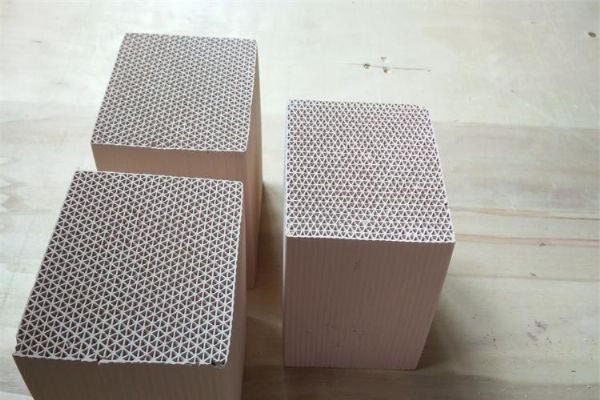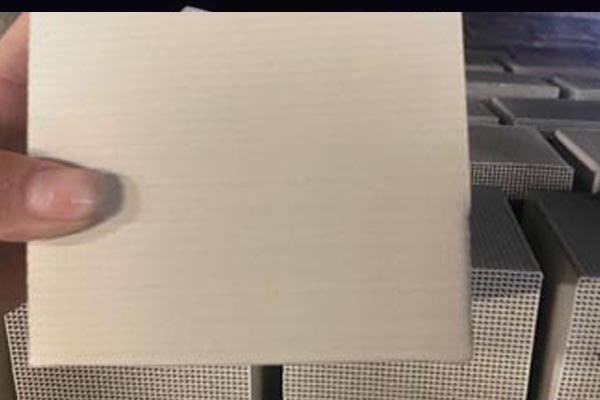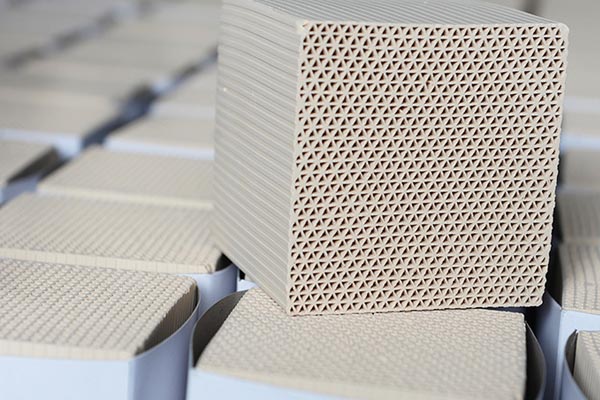
Because there are uniform small internal pores in the molecular sieve structure, Hunan When the molecular linear degree of reactants and products is close to the pore size of the crystal, the selectivity of catalytic reaction often depends on the corresponding size of the molecule and pore size. This selectivity is called shape selective catalysis. There are two mechanisms leading to shape selectivity. One is caused by the difference of diffusion coefficient of molecules participating in the reaction in the pore cavity, which is called mass transfer selectivity; The other is caused by the space limitation of the transition state of the catalytic reaction, which is called transition state selectivity. Molecular sieve has clear pore cavity distribution, extremely high internal surface area (600m2/s), good thermal stability (1000 ℃), and adjustable acid site center. The acidity of molecular sieve mainly comes from three coordinated aluminum atoms and aluminum ions (AlO)+on the framework and in the pores. The OH based acid sensitive site center on the molecular sieve HY obtained by ion exchange, and the aluminum ion outside the framework will strengthen the acid site, forming the L acid site center. Polyvalent cations such as Ca2+, Mg2+and La3+can show the acid site center after exchange. The reduction of transition metal ions such as Cu2+and Ag+can also form acid site centers. In general, the higher the Al/Si ratio, the higher the specific activity of OH group. The modification of zeolite acidity can introduce protons through direct exchange of dilute hydrochloric acid. purchase This method often leads to dealumination of molecular sieve framework. So NaY will become NH4Y and then HY.

purchase There are cavities and channels in the crystal structure of zeolite with large adsorption capacity, whose volume accounts for more than 50% of the total volume of zeolite crystals. Moreover, the micropores of zeolite are evenly distributed, and the pore size is small, which is equivalent to the molecular size of general substances. The internal surface area of zeolite crystals can reach more than 1000 square meters. Therefore, the adsorption capacity of zeolite is particularly large. The main material of honeycomb zeolite adsorbent is natural zeolite. The manufacturer of zeolite is composed of silica Inorganic microporous material composed of al_2o_3 and alkaline metal or alkaline earth metal, with inner pore volume accounting for 40-50% of the total volume and specific surface area of 100-500 m2/g, is characterized by high temperature resistance, non flammability, good thermal stability and hydrothermal stability. It is an efficient molecular sieve carrier with good adsorption performance, no secondary pollution, and can be regenerated at high temperature. Compared with honeycomb activated carbon, its performance is about 25% of its efficiency, However, it is widely used in the fields of adsorption, separation, catalysis and environment due to its high temperature resistance and difficult ignition. It is more suitable for the treatment of organic waste gas with large air volume and low concentration.

production Microporous molecular sieves with molecular apertures below 2 nm, mesoporous molecular sieves with molecular apertures above 50 nm (macroporous molecular sieves with molecular apertures above 50 nm), mesoporous molecular sieves have high specific surface area, regular and orderly pore structure, narrow pore size distribution, continuous and adjustable pore size and other characteristics, which make it difficult to complete the adsorption and separation of macromolecules in many microporous molecular sieves, And catalytic reaction. Therefore, molecular sieve materials with different properties and pore sizes shall be configured according to the different components of organic waste gas during selection, so as to achieve targeted organic waste gas treatment, meet the design requirements and emission standards. The main material of honeycomb zeolite adsorbent is natural zeolite. The manufacturer of zeolite is composed of silica Inorganic microporous material composed of al_2o_3 and alkaline metal or alkaline earth metal, with inner pore volume accounting for 40-50% of the total volume and specific surface area of 100-500 m2/g, is characterized by high temperature resistance, non flammability, good thermal stability and hydrothermal stability. It is an efficient molecular sieve carrier with good adsorption performance, no secondary pollution, and can be regenerated at high temperature. Compared with honeycomb activated carbon, its performance is about 25% of its efficiency, However, it is widely used in the fields of adsorption, separation, catalysis and environment due to its high temperature resistance and difficult ignition, purchase It is more suitable for the treatment of organic waste gas with large air volume and low concentration.

purchase The high reliability makes users no longer worry about unexpected shutdown, which is the confidence brought by UOP molecular sieve. Traditional molecular sieves can be used as desiccants, adsorbents and ion exchangers. UOP also provides high silicon zeolite series molecular sieves for non-traditional applications, including molecular sieves to remove organisms that affect the taste of food and drinks or cause odor. Zeolite molecular sieves have crystal structure and characteristics, the surface is a solid skeleton, and the internal holes can play the role of adsorption molecules. There are channels between the holes to connect with each other, and molecules pass through the channels. Due to the crystalline nature of the pores, the pore size distribution of the molecular sieve is very uniform. Molecular sieves selectively adsorb molecules according to the size of holes in their crystals, that is, they adsorb molecules of a certain size and repel molecules of larger substances, so they are vividly called "molecular sieves". The adsorption or repulsion function of molecular sieves is affected by the molecular electricity. Synthetic zeolite has the special function of selective adsorption according to the size and polarity of molecules, so it can dry or purify gas or liquid, which is also the basis of molecular sieve for separation. Hunan Synthetic zeolite can meet the extensive demand of industry for adsorption and selective products, and is also widely used in industrial separation to synthesize zeolite molecular sieves. Advantages of UOP molecular sieve

purchase Due to its large pore size, mesoporous materials have become a good carrier for molecular reaction with large size. However, the pore wall of mesoporous materials is amorphous, so their hydrothermal stability and thermal stability cannot meet the harsh conditions required for petrochemical applications. Because there are metal ions with low electricity price and large ion radius and water in the combined state, water molecules are continuously lost after heating, but the crystal skeleton structure remains unchanged, forming many cavities with the same size. The cavities are connected by many micropores with the same diameter. These tiny holes have uniform diameters, which can absorb molecules smaller than the diameter of the hole into the interior of the hole, By excluding molecules larger than pores, molecules with different shapes, diameters, polarities, boiling points and saturation levels can be separated, production It has the function of "screening" molecules, so it is called molecular sieve. At present, molecular sieves are widely used in metallurgy, chemical industry, electronics, petrochemical industry, natural gas and other industries.




